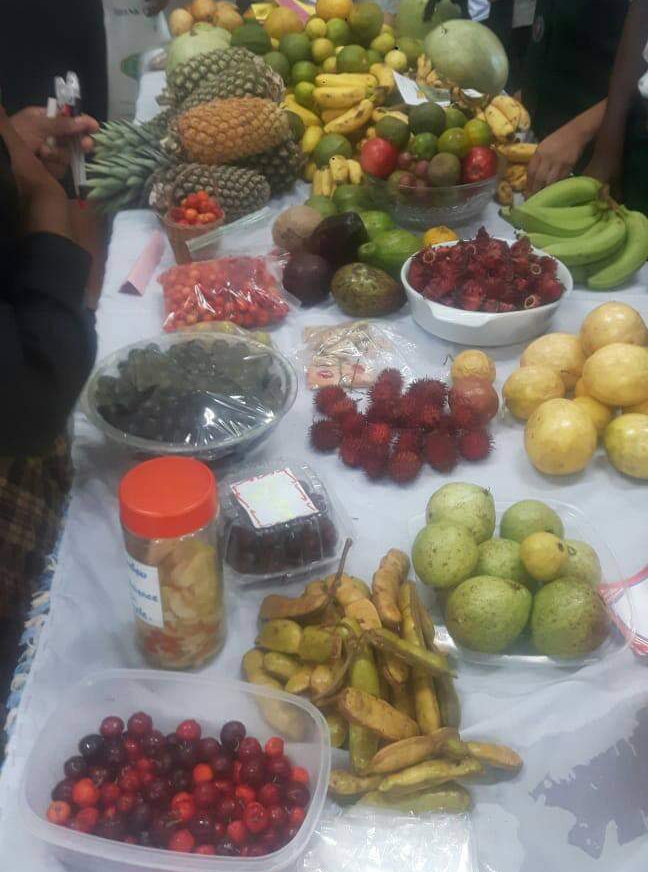
By Kafayat A. Adebayo
Food safety involves preventing or reducing presence of food contaminants such as microbial, chemical, physical hazards and even allergens that may occur along the food supply chain and have negative health impact on the consumers. The World Food Safety day is celebrated by United Nations (UN) on 7th June anually and this year theme is “safer food, better health”. Food safety is key to achieving several UN Sustainable Development Goals and is a shared responsibility between governments, producers and consumers. You are what you eat. It’s what we are made to believe by our mothers and doctors. An apple a day keeps the doctor away. But today, not just eating, even shopping for your daily needs has never been more complex. From reports of already contaminated soil and water to promiscuous use of different agro-chemicals like pesticides to reduce spoilage, chemical waxing on fruits, artificial ripening agents, formalin to preserve fruits just to mention a few. In some sense it may be more appropriate to say we are what we don’t eat.
Fruit and vegetables are major contributors to human wellbeing. They are sources of very important micro-nutrients that contribute to proper functioning and development in man. The World Health Organisation (WHO) even recommends five servings of fruits and vegetables every day for a healthy living. Many health benefits attributed to fruits consumption include: prevention of free radicals due to abundant antioxidants; development of cognitive functions; aids absorption of other nutrients; strengthening immunity, thus helps fight diseases and so on. Many people are willing to get these beneficial products at any price all year round especially if they are very fresh. There are different types of fruits that are grown at different seasons in different climatic conditions globally. Fruits are perishable with very short life spans and the post-harvest loss can be very significant.
Fruit ripening is a natural process that completes the maturation of fruits and makes them attractive to the consumers. It involves the production of a hormone known as ethylene. Ethylene is a naturally occurring plant hormone that is produced by many fruits and vegetables. It affects the physiological processes in plants and initiates the ripening process. This improves the physical and organoleptic qualities like starch hydrolysis, softening, acidity, colour, taste and flavour. Farmers have little control on this natural process and may not have their produce ready at the same time, thus missing the premium sale period. In order to reduce post-harvest loss, matured raw fruits are harvested and ripened artificially at the destination market before sale. This is generally carried out on climacteric fruits which can be further ripened during transit and storage (banana, guava, apple, pawpaw, mango and tomato). Externally applied ethylene gas at a concentration up to 100ppm is the safe permissible option if used correctly can also initiate the ripening process. But due to high cost and scarcity of ethylene gas, many ethylene analogues are now used in place of the natural hormone.
Other chemicals like ethephon/ethereal, propylene, ethyleneglycol, ethanol and calcium carbide are being extensively applied without adequate regulations as artificial ripening agents in fruit supply chain. These artificially ripened fruits are being consumed by people without knowing the severe health risks of these hazardous chemicals. The health effects of these chemicals are so severe that toxicity will remain in the next generation. The most common ripening agent is calcium carbide (CaC2), a chemical compound that is colourless when pure, but most samples have a colour ranging from black to grayish-white. The reaction of calcium carbide with water was discovered by Friedrich Wohler in 1862. This reaction is the basis of the industrial manufacture of acetylene as major industrial use of calcium carbide. It is used to make acetylene gas (for use in acetylene torches for welding) and in the manufacturing of plastics (polyvinyl chloride). It is also used inform of calcium cyanamide as fertilizer, used in steel making, used in small carbide lamps called carbidecandles.The CaC2 content of a product is assayed by measuring the amount of acetylene produced on hydrolysis. Impurities present in the carbide include phosphide, which produces phosphine when hydrolyzed with heavy metals like arsenic. It is cheap, readily available and affordable withouit much legal scrutiny. This article aims at discussing effects on fruits, its implications and health risks to fruit farmers, vendors and consumers.Fruit farmers in trying to make their produce available and ready to eat all year round started the anomalous use of acethylene. The experiments reported that the “carbide treatment” hastens the ripening processes of fruits and vegetables in both favorable and unfavorable conditions.. According to scientists, when calcium carbide comes in contact with moisture in the atmosphere, it produces acetylene gas, which like ethylene accelerates the ripening process. Using this chemical in fruit industry is being discouraged worldwide due to dangers of explosion and carryover of toxic materials like arsenic and phosphorus to consumers, thus making the healthy fruit poisonous. In western countries, many stringent laws are being implemented and well monitored. Good Manufacturng Practices (GMP) have been put in place. Most Asian countries like India, Pakistan, Malaysia have food laws banning the use of calcium carbide. In Africa countries like Nigeria, Kenya and Ghana, upsurge in use of calcium carbide have been reported. Most especially that the chemical is of low grade with a lot of impurities. Since no technical knowledge is considered necessary for its anomalous use, higher quantity of calcium carbide than needed to ripen immature fruit render them tasteless.
Hazards caused by Calcium carbide
Effects due to inhalation by farmers: It causes mouth, nose, throat and lung irritation with coughing and severe shortness of breath (pulmonary oedema), rapid irregular breathing, headache and burns to mucous membranes. Repeated inhalation may cause chronic bronchitis.
Effects due to ingestion by consumers: It causes digestive, respiratory and gastrointestinal tract burns, nausea, vomiting, bloating and headache.
Effect due to skin contact by farmers: Calcium carbide may cause severe skin irritation, rash, burning feeling, redness, with possible burns. When in contact with moist skin, caustic lime is formed, which can lead to ulceration and scarring. Repeated/prolonged skin contact may cause dryness or rashes.
Effects due to impurities such as arsenic and phosphorous: The commonly involved organ systems in heavy metal toxicity include the central nervous system, peripheral nervous system, gastrointestinal, renal, and cardiovascular system. People exposed to high levels of arsenic can have nausea and vomiting, diarrhoea, anaemia, and low blood pressure. These symptoms may be followed by a feeling of “pins and needles” in the hands and feet (neuropathy). Chronic (long-term) exposure to arsenic can cause stomach ailments, headaches, fatigue, dark splotches on the skin, and small “corns” or “warts” on the palms of the hands, soles of the feet. People exposed to inorganic arsenic can have cancer of the lung, skin, bladder, liver, kidney, and prostate
A Fruit seller’s advice
A recently discussion with a fruit seller on a University Campus gave an insight into artificial fruit ripening. She said many unknown chemicals are actually available in main local fruit markets that are used in fruit ripening but calcium carbide is one of the most readily available. Sometimes, other fruits used include habanero pepper, bush mango (Irvingia gabonesis), and apples. Carbide use is more common in chilling/raining seasons because amount of heat generated is often less than what normally induces ripening. She stated that most hawkers quickly buy unripe fruits, apply carbide and sell immediately to maximise profits. She advised that it is better to buy fruits from a stall rather than hawkers. She added no buying of peeled fruits because most vendors lack GHP and are often culprits with carbide. She finally requested that more awareness should be done through training of fruit sellers and the public. The government should put in place laws and adequate monitoring to reduce the use of the popular but dangerous chemical.
How to detect fruits ripened with calcium carbide
Experts have said that the ultimate way of detecting a fruit that has been artificially ripened by calcium carbide is by laboratory analysis, but an ordinary person can distinguish artificially ripened fruits from those naturally ripened by noting the brownish dark spots on naturally ripened fruits but which are absent on artificially ripened ones. In the case of banana, the fruit will be yellow while the stem will be dark green. Artificially ripened fruits may also have some powdery substance because at times some sellers don’t even bother to wash them well.
In Nigeria, many governmental ministries and agencies are responsible for developing food safety standards such as Standard Organisation of Nigeria (SON), Nigeria Agency for Food Drug Administration and Control (NAFDAC) and Consumer Protection Council (CPC). These agencies must work together and come up with specific laws and associated punishments for the defaulters concerning sale of safe fruits. Standard Operating Procedures (SOP) should be developed for fruit ripening and farmers’ association trained on its benefits and uses. But how easy is it for these regulatory bodies to discover defaulters in local wet market? The community and LGAs have a role to play; community heads should work closely with environmental hygiene officers to conduct market inspections. It becomes a high priority to conduct a sensitization/ awareness campaign to the farmers, vendors and the general public about this chemical hazard that is avoidable. Research must also be done in search of alternative and safe ripening agent that will be available and affordable.
Conclusion
It is important that there are strict laws banning the use of carbide in fruit ripening. Also massive awareness must be conducted to the farmers and the general public. Basic Good Hygiene Practices (GHP) and GMP such as washing fruits thoroughly with a lot of water, buying fruits in season, choosing fruits with uniform colour and dark spots, buying from reputable source, buying matured fruits and allowing them to ripe at home. The best method is to start a small fruit/vegetable garden at home. This will prevent/minimise accidental consumption of artificially ripened fruits.
Due to complex supply chain, farmers have growing demands during actual ripening seasons and also during the off seasons too. Therefore, new technology that are safe must be available. Since ethylene is the safe option, ethylene ripening chambers can serve as a promising option. For small scale local farmers, fruits that produce large volume of ethylene gas such as banana, pepper, apple and bush mango can be used in place of calcium carbide.
So as we mark the 2022 World food safety Day, lets us act now and know that it is our joint responsibility to ensure Safer food, better health for all!
Adebayo is of Port Health Services, Federal Ministry of Health, Ibadan. Contact via 08039197309 & kafaayatadebayo2013@gmail.com
PS: The views, thoughts, and opinions expressed in the text belong solely to the author, and not necessarily that of the Publishers of Precision Online Newspaper.















